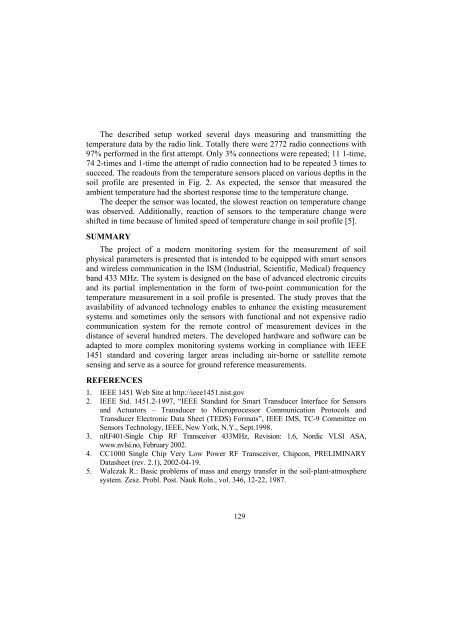C - Lublin
C - Lublin
C - Lublin
You also want an ePaper? Increase the reach of your titles
YUMPU automatically turns print PDFs into web optimized ePapers that Google loves.
The described setup worked several days measuring and transmitting the<br />
temperature data by the radio link. Totally there were 2772 radio connections with<br />
97% performed in the first attempt. Only 3% connections were repeated; 11 1-time,<br />
74 2-times and 1-time the attempt of radio connection had to be repeated 3 times to<br />
succeed. The readouts from the temperature sensors placed on various depths in the<br />
soil profile are presented in Fig. 2. As expected, the sensor that measured the<br />
ambient temperature had the shortest response time to the temperature change.<br />
The deeper the sensor was located, the slowest reaction on temperature change<br />
was observed. Additionally, reaction of sensors to the temperature change were<br />
shifted in time because of limited speed of temperature change in soil profile [5].<br />
SUMMARY<br />
The project of a modern monitoring system for the measurement of soil<br />
physical parameters is presented that is intended to be equipped with smart sensors<br />
and wireless communication in the ISM (Industrial, Scientific, Medical) frequency<br />
band 433 MHz. The system is designed on the base of advanced electronic circuits<br />
and its partial implementation in the form of two-point communication for the<br />
temperature measurement in a soil profile is presented. The study proves that the<br />
availability of advanced technology enables to enhance the existing measurement<br />
systems and sometimes only the sensors with functional and not expensive radio<br />
communication system for the remote control of measurement devices in the<br />
distance of several hundred meters. The developed hardware and software can be<br />
adapted to more complex monitoring systems working in compliance with IEEE<br />
1451 standard and covering larger areas including air-borne or satellite remote<br />
sensing and serve as a source for ground reference measurements.<br />
REFERENCES<br />
1. IEEE 1451 Web Site at http://ieee1451.nist.gov<br />
2. IEEE Std. 1451.2-1997, “IEEE Standard for Smart Transducer Interface for Sensors<br />
and Actuators – Transducer to Microprocessor Communication Protocols and<br />
Transducer Electronic Data Sheet (TEDS) Formats”, IEEE IMS, TC-9 Committee on<br />
Sensors Technology, IEEE, New York, N.Y., Sept.1998.<br />
3. nRF401-Single Chip RF Transceiver 433MHz, Revision: 1.6, Nordic VLSI ASA,<br />
www.nvlsi.no, February 2002.<br />
4. CC1000 Single Chip Very Low Power RF Transceiver, Chipcon, PRELIMINARY<br />
Datasheet (rev. 2.1), 2002-04-19.<br />
5. Walczak R.: Basic problems of mass and energy transfer in the soil-plant-atmosphere<br />
system. Zesz. Probl. Post. Nauk Roln., vol. 346, 12-22, 1987.<br />
129
















